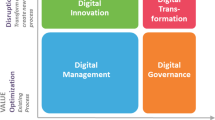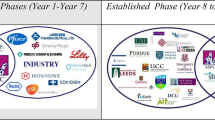Abstract
Establishing deeper engagement with industry and society has recently become a key concern of universities. To pursue this goal, universities—as well as other public research organizations—have started to reorganize internal resources, to redefine their activities and policies, and to redesign their overall knowledge transfer (KT) business models. As a consequence, in several countries a wide heterogeneity exists in the types of KT models adopted and in the outcomes arising from KT activities. By performing a cluster analysis and a multinomial logit regression on an extensive dataset that almost covers the entire population of Italian universities, in this study we analyze (1) whether models of KT characterized by a broader engagement with society are gradually substituting models more focused on technology commercialization, and (2) which factors related to the availability of resources and universities’ strategic intention better explain existing differences. Insights from the study might help university managers to define the most appropriate actions to fully undertake the implementation of the university third mission.




Similar content being viewed by others
Notes
Among the remaining universities that are not included in the NetVal survey, the largest fraction (11.5 %) is represented by “telematic universities”, which are specialized in distant (online) learning and that do not possess physical facilities to perform research activity. A smaller fraction (3.1 %) is represented by “universities for foreigners”, which are specialized in teaching Italian language, literature and culture, and that, similarly to “telematic universities”, are not involved in scientific/technological research. Finally, other excluded universities either have been very recently created, or are specialized in very narrow teaching areas (e.g., the University of Gastronomic Sciences, founded in 2004 by the international non-profit association Slow Food).
“Less than 10 years” and “more than 14 years” represent, respectively, the first and the fourth quartile of the distribution of the variable Experience computed for our sample universities. In this sense, Fig. 4 compares the behavior of the least experienced vs. the most experienced universities in terms of KT activity.
Dendrograms are available upon request.
Recall that in the cluster analysis only a measure of research impact was considered (i.e, NI), but no measures of research “amount” were included.
References
Balderi, C., Butelli, P., Conti, G., Di Minin, A. & Piccaluga, A. (2007). Towards an Italian way in the valorisation of results from public research. Impresa Progetto: Electronic Journal of Management, 1, DITEA. http://www.impresaprogetto.it/essays/2007-1/balderi-butelli-conti
Baldini, N., Fini, R., & Grimaldi, R. (2014). The transition towards entrepreneurial universities: An assessment of academic entrepreneurship in Italy. In A. N. Link, D. S. Siegel, & M. Wright (Eds.), The Chicago handbook of university technology transfer and academic entrepreneurship. Chicago, IL: University of Chicago Press.
Barney, J. B. (1991). Firm resources and sustained competitive advantage. Journal of Management, 17(1), 99–120.
Barney, J. B., Ketchen, D. J., & Wright, M. (2011). The future of resource-based theory. Journal of Management, 37(5), 1299–1315.
Bax, A., Corrieri, S., Daniele, C., Guarnieri, L., Parente, R., Piccaluga, A., et al. (2014). Unire i puntini per completare il disegno dell’innovazione - XI rapporto Netval sulla valorizzazione della ricerca pubblica italiana. Milano, IT: Fazzi Editore.
Bercovitz, J., & Feldman, M. (2006). Entpreprenerial universities and technology transfer: A conceptual framework for understanding knowledge-based economic development. The Journal of Technology Transfer, 31(1), 175–188.
Bonaccorsi, A., Daraio, C., & Simar, L. (2006). Advanced indicators of productivity of universities: An application of robust nonparametric methods to Italian data. Scientometrics, 66(2), 389–410.
Bozeman, B. (2000). Technology transfer and public policy: A review of research and theory. Research Policy, 29(4), 627–655.
Branscomb, L. M., Kodama, F., & Florida, R. L. (1999). Industrializing knowledge: University–industry linkages in Japan and the United States. London: MIT Press.
Cesaroni, F., Conti, G. & Piccaluga, A. (2005). Technology transfer offices (TTO) in Italian universities: What they do and how they do it. In 5th Triple Helix conference: “The capitalization of knowledge: Cognitive, economic, social and cultural aspects”, Turin, Italy, May 18th–21st.
Cesaroni, F., & Piccaluga, A. (2005). Universities and intellectual property rights in Southern European countries. Technology Analysis & Strategic Management, 17(4), 497–518.
Chesbrough, H. W. (2003). Open Innovation: The new imperative for creating and profiting from technology. Boston, MA: Harvard Business School Press.
Clark, B. R. (1998). Creating entrepreneurial universities: Organizational pathways of transformation. Oxford: International Association of Universities & Elsevier Science Ltd.
Cohen, W. M., Nelson, R. R., & Walsh, J. P. (2002). Links and impacts: The influence of public research on industrial R&D. Management Science, 48(1), 1–23.
Daraio, C., Bonaccorsi, A., Geuna, A., Lepori, B., Bach, L., Bogetoft, P., et al. (2011). The European university landscape: A micro characterization based on evidence from the Aquameth project. Research Policy, 40(1), 148–164.
Dosi, G. (1982). Technological paradigms and technological trajectories: A suggested interpretation of the determinants and directions of technical change. Research Policy, 11(3), 147–162.
Etzkowitz, H., & Leydesdorff, L. (2000). The dynamics of innovation: From National Systems and ‘Mode 2’ to a Triple Helix of university–industry–government relations. Research Policy, 29(2), 109–123.
Etzkowitz, H., Webster, A., Gebhardt, C., & Cantisano Terra, B. R. (2000). The future of the university and the university of the future: Evolution of ivory tower to entrepreneurial paradigm. Research Policy, 29(2), 313–330.
EUA, ProTon Europe, EARTO, & EIRMA. (2009). Responsible partnering—Joining forces in a world of open innovation. A guide to better practices for collaborative research between science and industry. Bruxelles, BE: European University Association. http://www.eua.be/Libraries/Publications_homepage_list/Responsible_Partnering_Guidelines_09.sflb.ashx
European Commission. (2004). Management of intellectual property in publicly-funded research organizations: Towards European guidelines. Bruxelles, BE: European Commission, Expert Group. http://ec.europa.eu/research/era/pdf/iprmanagementguidelines-report.pdf
Everitt, B. S., Landau, S., Leese, M., & Stahl, D. (2011). Cluster analysis. Chichester: Wiley.
Geuna, A., & Muscio, A. (2009). The governance of university knowledge transfer: A critical review of the literature. Minerva, 47(1), 93–114.
Geuna, A., & Nesta, L. (2006). University patenting and its effects on academic research: The emerging European evidence. Research Policy, 35(6), 790–807.
Gibbons, M., Limoges, C., Nowotny, H., Schwartzman, S., Scott, P., & Trow, M. (1994). The new production of knowledge: The dynamics of science and research in contemporary societies. London: Sage.
Greene, W. H. (1997). Econometric analysis. Upper Saddle River, NJ: Prentice-Hall.
Jacobsson, S., Lindholm-Dahlstrand, A., & Elg, L. (2013). Is the commercialization of European academic R&D weak? A critical assessment of a dominant belief and associated policy responses. Research Policy, 42(4), 874–885.
Laursen, K., & Salter, A. (2004). Searching high and low: What types of firms use universities as a source of innovation? Research Policy, 33(8), 1201–1215.
Lazzeroni, M., & Piccaluga, A. (2003). Towards the entrepreneurial university. Local Economy, 18(1), 38–48.
Link, A. N., Siegel, D. S., & Bozeman, B. (2007). An empirical analysis of the propensity of academics to engage in informal university technology transfer. Industrial and Corporate Change, 16(4), 641–655.
Lowe, R. A. (2006). Who develops a university invention? The impact of tacit knowledge and licensing policies. The Journal of Technology Transfer, 31(4), 415–429.
Merton, R. K. (1973). The sociology of science: Theoretical and empirical investigations. Chicago, IL: University of Chicago press.
Mowery, D. C., Nelson, R. R., Sampat, B. N., & Ziedonis, A. A. (2001). The growth of patenting and licensing by US universities: An assessment of the effects of the Bayh-Dole act of 1980. Research Policy, 30(1), 99–119.
Muscio, A. (2010). What drives the university use of technology transfer offices? Evidence from Italy. The Journal of Technology Transfer, 35(2), 181–202.
Nelson, R. R. (2001). Observations on the post-Bayh-Dole rise of patenting at American universities. The Journal of Technology Transfer, 26(1), 13–19.
O’Gorman, C., Byrne, O., & Pandya, D. (2008). How scientists commercialise new knowledge via entrepreneurship. The Journal of Technology Transfer, 33(1), 23–43.
Perkmann, M., Tartari, V., McKelvey, M., Autio, E., Broström, A., D’Este, P., et al. (2013). Academic engagement and commercialisation: A review of the literature on university–industry relations. Research Policy, 42(2), 423–442.
Perkmann, M., & Walsh, K. (2008). Engaging the scholar: Three types of academic consulting and their impact on universities and industry. Research Policy, 37(10), 1884–1891.
Philpott, K., Dooley, L., O’Reilly, C., & Lupton, G. (2011). The entrepreneurial university: Examining the underlying academic tensions. Technovation, 31(4), 161–170.
Piccaluga, A. & Conti, G. (2011). Technology Transfer Office (TTO). In A. Bonaccorsi & M. Bucchi (Eds.), Trasformare conoscenza trasferire tecnologia. Dizionario critico delle scienze sociali sulla valorizzazione della conoscenza (pp. 214–216). Venezia, IT: Marsili.
Plewa, C., Korff, N., Johnson, C., Macpherson, G., Baaken, T., & Rampersad, G. C. (2013). The evolution of university–industry linkages: A framework. Journal of Engineering and Technology Management, 30(1), 21–44.
Ramos-Vielba, I., & Fernández-Esquinas, M. (2012). Beneath the tip of the iceberg: Exploring the multiple forms of university–industry linkages. Higher Education, 64(2), 237–265.
Rothaermel, F. T., Agung, S. D., & Jiang, L. (2007). University entrepreneurship: A taxonomy of the literature. Industrial and Corporate Change, 16(4), 691–791.
Salter, A., D’Este, P., Pavitt, K., Scott, A., Martin, B. R., Geuna, A., et al. (2000). Talent, not technology: The impact of publicly funded research on innovation in the UK. Brighton: SPRU-University of Sussex.
Sánchez-Barrioluengo, M. (2014). Articulating the ‘three-missions’ in Spanish universities. Research Policy, 43(10), 1760–1773.
Schoen, A., de la Potterie, B. V. P., & Henkel, J. (2014). Governance typology of universities’ technology transfer processes. The Journal of Technology Transfer, 39(3), 435–453.
Siegel, D. S., Veugelers, R., & Wright, M. (2007). Technology transfer offices and commercialization of university intellectual property: Performance and policy implications. Oxford Review of Economic Policy, 23(4), 640–660.
Thursby, J. G., & Thursby, M. C. (2011a). Faculty participation in licensing: Implications for research. Research Policy, 40(1), 20–29.
Thursby, J. G., & Thursby, M. C. (2011b). University–industry linkages in nanotechnology and biotechnology: Evidence on collaborative patterns for new methods of inventing. The Journal of Technology Transfer, 36(6), 605–623.
Van Looy, B., Callaert, J., & Debackere, K. (2006). Publication and patent behavior of academic researchers: Conflicting, reinforcing or merely co-existing? Research Policy, 35(4), 596–608.
Van Looy, B., Landoni, P., Callaert, J., van Pottelsberghe, B., Sapsalis, E., & Debackere, K. (2011). Entrepreneurial effectiveness of European universities: An empirical assessment of antecedents and trade-offs. Research Policy, 40(4), 553–564.
Van Looy, B., Ranga, M., Callaert, J., Debackere, K., & Zimmermann, E. (2004). Combining entrepreneurial and scientific performance in academia: Towards a compounded and reciprocal Matthew-effect? Research Policy, 33(3), 425–441.
Verheugen, G. & Potocnik, J. (2005). Responsible partnering—A guide to better practices for collaborative research and knowledge transfer between science and industry. Bruxelles, BE: European Commission, DG Enterprise & Industry. http://www.eua.be/Libraries/Research/2005_Responsible_Partnering_rp-2005-v102_2.sflb.ashx
Zucker, L. G., Darby, M. R., & Brewer, M. B. (1998). Intellectual human capital and the birth of US biotechnology enterprises. American Economic Review, 88(1), 290–306.
Acknowledgments
We would like to thank Claudia Daniele for her assistance in data collection and elaboration, Giorgio Calcagnini, Ilario Favaretto and participants to the International Conference on Technology Transfer (University of Urbino, October 30–31, 2014) for their useful comments on an earlier version of this paper.
Conflict of interest
Author Andrea Piccaluga is currently President of Netval (www.netval.it), the Italian network of University Technology Transfer Offices, which provided most of the data used in this study. Author Fabrizio Cesaroni declares that he has no conflict of interest.
Ethical standard
This article does not contain any studies with human participants or animals performed by any of the authors.
Informed consent
Informed consent was obtained from all individual participants included in the study.
Author information
Authors and Affiliations
Corresponding author
Rights and permissions
About this article
Cite this article
Cesaroni, F., Piccaluga, A. The activities of university knowledge transfer offices: towards the third mission in Italy. J Technol Transf 41, 753–777 (2016). https://doi.org/10.1007/s10961-015-9401-3
Published:
Issue Date:
DOI: https://doi.org/10.1007/s10961-015-9401-3
Keywords
- Knowledge transfer
- Knowledge transfer offices
- Academic engagement
- University third mission
- Entrepreneurial university
- University–industry collaboration




